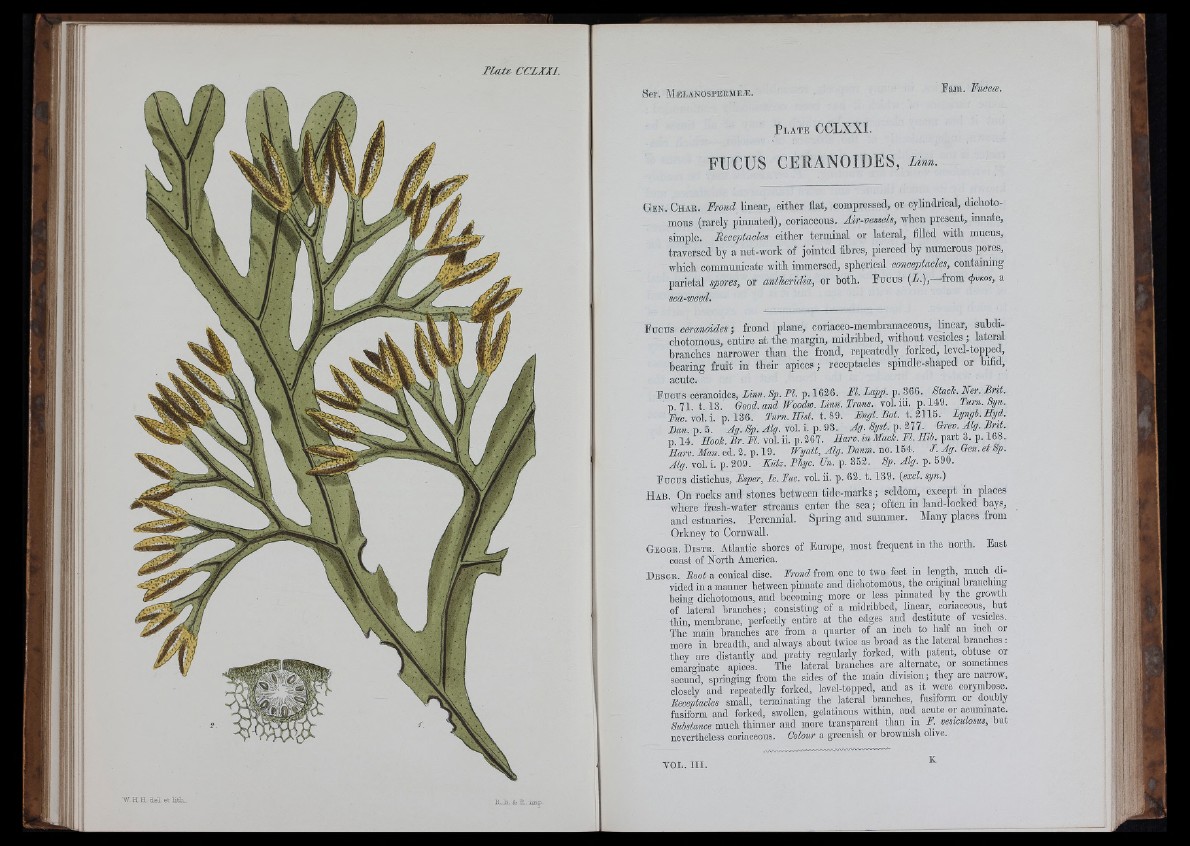
w
ii'
î v
H
. 1
Bd V
Ser. M elanospermeæ.
P l a t e CCLXXI.
FUCUS CERANOIDES, Linn.
G en . Ch a r . Froud linear, either flat, compressed, or cylindi’ical, dielioto-
mous (rarely pinnated), coriaceous. Air-vessels, when present, innate,
simple. Receptacles either terminal or lateral, filled with mucus,
traversed by a net-work of jointed fibres, pierced by numerous pores,
wliich communicate with immersed, spherical conceptacles, containing
parietal spores, or antheridia, or both. Fucus ( i .) , from )>vK.az, a
sea-weed.
Fücus ceranoides; frond plane, ooriaceo-membranaceous, bnear, suhdi-
chotomons, entire at the margin, midribbed, without vesicles ; lateral
branches narrower than the frond, repeatedly forked, level-topped,
bearing fruit in their apices; receptacles spindle-shaped or bihd,
acute.
Fucus ceranoides, Lmn. Sp. FI. p. 1626. FI. Lapp. p. 866. Stack. Ner. Brit.
n 71 1 .13. Good, a n d Woodw. Linn. Trans, vol. in. p. 149. Turn. Syn.
A c vol. i. p. 136. Turn. Eist. t.Z9i. Fnyl. Bot. Lymjb.Eyd.
Ban. p. 5. Ay. Sp. Alg. vol. i. p. 93. Ag. Syst. p. 277. Grev Alg. Brü.
p. 14. Eook. Br. FI. vol. ii. p. 267. Earv. in Maok. FI. E ii. part 3. p. 168.
Earv Man. ed. 2. p. 19. Wyatt, Alg. Banm. no. 154. J. Ag. Gen. et Sp.
Alg. vol. i. p. 209. Kütz. Fhyc. Un. p. 352. Sp. Alg. p. 590.
Fuco s distichus, Ksper, Ic.Fuc. vol. ii. p. 62. 1 .139. {excl. syn.)
H a b . O n rocks and stones between tide-marks ; seldom, except in places
whore fresh-water streams enter the sea ; often in land-looked bays,
and estuaries. Perennial. Spring and summer. Many places irom
Orkney to Cornwall.
Geogr. D istk . Atlantic shores of Europe, most frequent in the north. East
coast of North America.
D e sc r . Root a conical disc. Frond from one to two feet in length much divided
in a manner between pinnate and dichotomous, the original branching
being dichotomous, and becoming more or less pinnated by the growth
of lateral branches; consisting of a midribbed, linear, coriaceous, but
thin, membrane, perfectly entire at the edges and destitute ot vesicles.
The main branches are from a quarter of an inch to halt an inch or
more in breadth, and always about twice as broad as the lateral branches :
they are distantly and pretty regularly forked, with patent, obtuse or
emarginate apices. The lateral branches are alternate, or sometimes
secund, springing from the sides of the main division; they are narrow,
closely and repeatedly forked, level-topped, and as it were corymbose.
Receptacles small, terminating the lateral branches, fusiform or doubly
fusiform and forked, swollen, gelatinous within, and acute or acuminate.
Substance much thinner and more transparent than m F. vesiculosus, but
nevertheless coriaceous. Colour a greenish or brownish olive.
VOL. I I I .
•WHH.del.etliÛL.